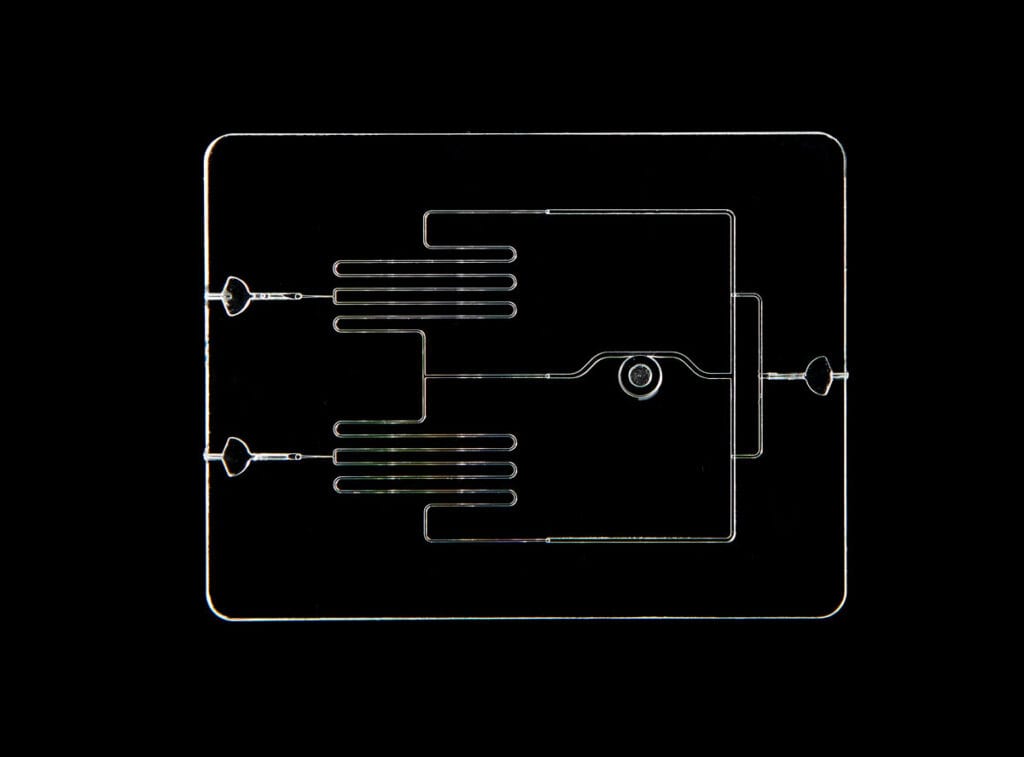We have covered at length the important role microfluidics and microfluidic devices are playing across a wide range of industries. In this post however, we are doing a sort of Microfluidic Devices: 101. In this post we’ll cover the definition of a microfluidic device, how it is different from a microfluidic chip, and the different types of microfluidic devices available. Let’s get started.
What is a microfluidic device?
A microfluidic device is something that processes a small amount of fluid. This “small” amount can range from a nanoliter to a milliliter. A microfluidic device represents a microfluidic channel plus all of the relevant micro-features plus inlet/outlet ports that make it work.

What is the Difference Between a Microfluidic Device and a Microfluidic Chip?
A microfluidic chip can have multiple microfluidic devices on it. In fact, the word microfluidic chip is actually borrowed from the electronics industry. It usually means the physical platform which houses a microfluidic device, or devices. Microfluidic chips usually range in size from 1cm to 10cm, and typically look like a microscope slide. One microfluidic chip can house multiple microfluidic devices.
Types of Microfluidic Devices
Straight Channel
A single straight microchannel device comes with one inlet and one outlet. A single channel is the first choice when the researcher is evaluating material compatibility; such as optical, thermal, chemical, or surface properties. Sometimes a straight channel microfluidic device is used in cell culture studies to optimize reagents, channel dimensions, flow rates, or channel coating for each specific cell type or size. There are many Microfluidics applications for a straight channel microfluidic device.
Y-Channel
Y-channel microfluidic devices are mainly used in separation applications. Typically, a heterogeneous mixture of particles such as cells enters from one side, separated at the junction, and then delivered via outlet ports. Many physical or flow characteristics could be used in Y-Channel Microfluidic devices to drive the separation such as magnetic, electrical, acoustic, thermal, laser, sheath flow, gravity, etc. Y Channels are also used as mergers when two different flows enter from one side and a mixture exits.
T-Junction
In a typical T-junction Microfluidic device, there is a main straight channel and a perpendicular side channel that connects to the main channel somewhere. These microfluidic devices are usually used for the generation of droplets, such as water-in-oil or oil-in-water. These devices are simple, but are very useful.
Cross-Junction
Cross-Junction Microfluidic devices are made when two perpendicular channels connect to the main channel symmetrically. The cross junction acts as a sort of micro-nozzle, creating a flow-focusing phenomenon. Recently many flow-focusing droplet generators have been introduced for high-throughput sequencing of single cells.
Spiral
Spiral Microfluidic devices are generally a single spiraling channel that branches at the outside end of the channels. Flow normally enters from the center of the spiral and exits from the outside. Spiral channels are generally used for the separation and sorting of particles caused by inertia. Different sizes, weights, and/or shapes of particles can be separated using this method. The number of branches from which the particles exit can number anywhere between two and ten.
Micro-Mixing
The laminar nature of flow in microfluidic channels means the dominant mixing force is diffusion. This is more pronounced in smaller micro-channels. Mixing two different reagents in micro-channels could be very challenging, especially in the case of immiscible liquids such as water and oil, or different viscosity of liquid — syrup and water. If mixing is needed, then one may choose a micro-mixer microfluidic device. Micro-mixers work by creating local turbulent flow, there are many designs and geometries, but the two most famous devices are serpentine mixers and herringbone mixers.
Micro-Reactor
Micro-reactor devices are also known as microfluidic chamber or flowcells. These are microfluidic devices that have a cavity feature along the channel. These devices are used when a liquid must undergo chemical, physical, or biological reactions. Heat, UV light, and/or time is needed to activate the reaction. An example of a micro-reactor device might be a point of care medicine device.
Merging Micro-Channels
Spiral Microfluidic devices are generally a single spiraling channel that branches at the outside end of the channels. Flow normally enters from the center of the spiral and exits from the outside. Spiral channels are generally used for the separation and sorting of particles caused by inertia. Different sizes, weights, and/or shapes of particles can be separated using this method. The number of branches from which the particles exit can number anywhere between two and ten.
Splitting Devices
Splitting microfluidic devices are used when the flow needs to be divided into specific ratios. rug delivery and gene delivery are some of the examples of splitting microfluidic devices.
Citrogene: Microfluidic Device Fabrication Experts
When it comes to producing the ideal microfluidic device for your specific needs, there’s only one microfluidic partner to consider: Citrogene. Our proprietary process allows us to create precise, customized, state-of-the-art microfluidic devices based on your needs, all produced in glass. Contact us today to learn more.
